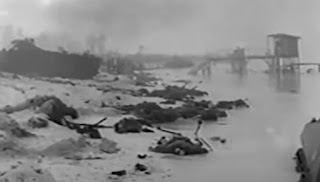 |
| US marines advancing cautiously at Tarawa, 1943 |
Located in the middle of the Pacific Ocean, the Tarawa atoll is barely visible from the world map. Yet it was the site of one of the major battles of World War 2.
 |
| Location of Tarawa on Google maps |
On 10 December 1941, Imperial Japanese forces landed in Tarawa as part of their invasion of the Gilbert Islands. However, they only started fortifying the island in September 1942 as they had expected an impending American invasion. The island was further reinforced by the arrival of 6th Yokosuka Special Naval Landing Force (SNLF, aka Japanese marines). A further 1,200 Korean labourers were brought over to help construct defences. Rear Admiral Keiji Shibazaki was in charge of the defence of Tarawa, and boasted that "it would take one million men one hundred years" to conquer Tarawa.
To the Americans, Tarawa was seen as important as the capture of the Central Pacific islands meant bringing the war closer to Japan geographically speaking. It would the first American sea-to-land offensive in the Central Pacific. The invasion would take place in 20 November 1943.
A glance at Tarawa shows the difficulty in fighting in the terrain. Not only had the US marines shallow landing ground, there was little cover to protect from oncoming Japanese fire.
20 November 1943
pre-dawn- The American Navy (17 carriers, 12 battle ships, 8 heavy cruisers, 4 light cruisers and 66 destroyers) opened fire on the Tarawa after Japanese artillery fired on the ships. The Americans destroyed 3 of 4 Japanese big guns in short order. The Americans continue to pepper the island to clear the beaches for landing (mainly in the North and West).
0900 - The beaches proved to be even more shallow than expected as the Marines started to make their landing. Landing craft were stuck on the beaches, leaving the soldiers exposed. The Japanese made their counter attacks, causing the Marines to suffer their first casualties.
1200 - The Marines secured the beaches, allowing more equipment and soldiers to reinforce them.
1530 - The Marines advanced further inland. Rear Admiral Keiji Shibazaki and the senior officers were killed by a destroyer shell in the mid-afternoon.
1900 - The Americans tanks advanced half-way across the island. The Marines had suffered1500 casualties by nightfall.
21 November 1943
0800 - Even more equipment arrived on the western beaches. The Japanese contested the landings but to no avail.
1230 - The Americans launch a major offensive to take the airfield (located around the centre of the island). By mid-afternoon they captured it.
1930 - The Japanese attempted a small-scale counter attack but it failed.
22 November 1943
0400 - Over 300 Japanese attempted a banzai attack, killing 45 and wounding 128 Marines. The Japanese were pushed back.
0800 - The Marines launch another offensive to secure the island.
1330 - The island was declared secure.
Aftermath
The Japanese lost 4690 men, and only 17 Japanese soldiers surrendering and 129 Korean labourers were captured.
The Marines suffered 1009 dead and 2101 wounded. The heavy losses (and 1:1 casualties with the Japanese) caused an outcry in the United States. Many historians till this day debate on the importance of capturing Tarawa. After all, it was the first time that the Japanese mounted a serious opposition to an American amphibious landing.
Regardless of the views on Tarawa, it showed that the Pacific campaign of World War 2 would be a long one.


Comments